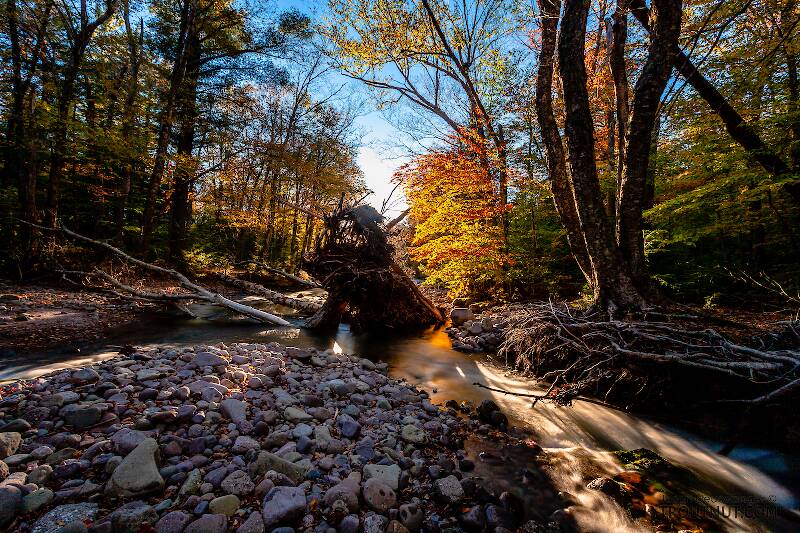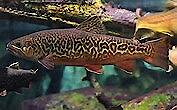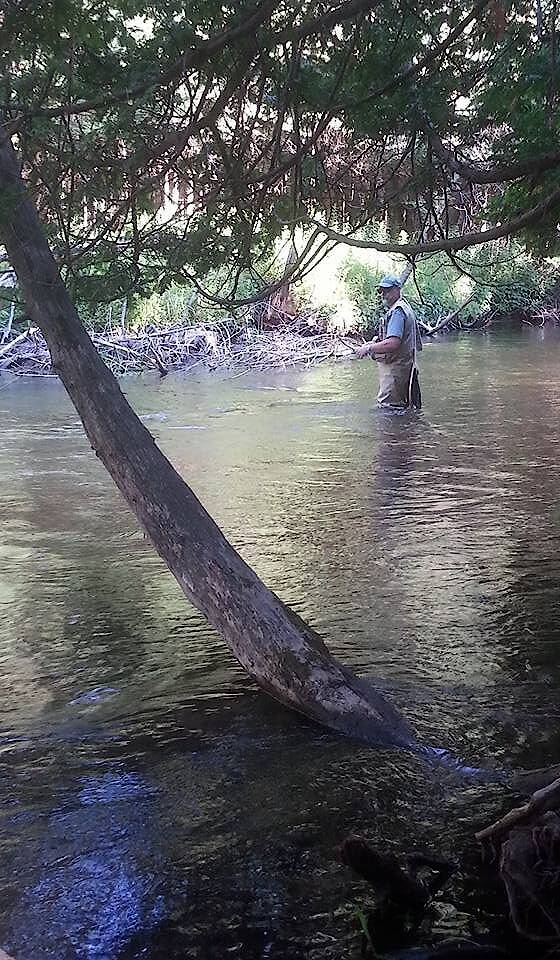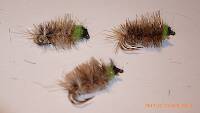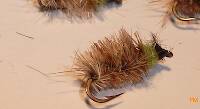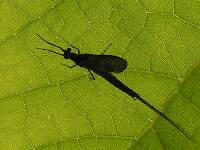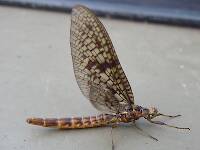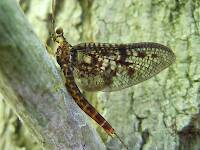
Blue-winged Olives
Baetis
Tiny Baetis mayflies are perhaps the most commonly encountered and imitated by anglers on all American trout streams due to their great abundance, widespread distribution, and trout-friendly emergence habits.
Featured on the forum

This one seems to lead to Couplet 35 of the Key to Genera of Perlodidae Nymphs and the genus Isoperla, but I'm skeptical that's correct based on the general look. I need to get it under the microscope to review several choices in the key, and it'll probably end up a different Perlodidae.

Troutnut is a project started in 2003 by salmonid ecologist Jason "Troutnut" Neuswanger to help anglers and
fly tyers unabashedly embrace the entomological side of the sport. Learn more about Troutnut or
support the project for an enhanced experience here.
Flytyerinpa on Dec 20, 2016December 20th, 2016, 5:29 am EST
As I was laying in bed last night waiting for sleep to over take me I started thinking about if or how I could have cough more trout last year. Which lead me to think about all the different colors of feathers. Are they all really necessary ? I'm just talking the natural colors, I'm sure I have not seen all the colors, but in the past couple years I've saw L,M,D, Blue Dun, Rusty Dun, L,M,D, Brown Dun, L,M,D, Barred Dun, L,M,D, Brown L,M,D, Ginger, Golden Badger, Silver Badger, Speckled Badger, Black, White, Crean, Ghost White, Furnace, Pale Watery Dun, Lite Ginger Dun, L,M,D, Barred Ginger, and Natural Dun. Now I'm wondering if maybe I bit off more than I can chew learning to tie fly's And if you take into consideration all the colors of chenille, floss, threads, wools, furs, and all the different sizes and styles of hooks. I don't think your ever to young to start fly tying, of course this is coming from an old guy that grew up when playing with lead was a common thing, handling Mercury in school was just a fun thing to do, just about everybody smoked and drank, eggs and bacon was a normal breakfast, nobody ever heard of cholesterol or any of the other things they claim are killing us today. Yep think I should have been born about 5 years ago, and started tying flies on later than age 6 just not enough time in a normal life time to learn everything there is to know about fly tying and fly fishing. The normal working guy gets 1 maybe 2 days a week of fishing in and here the fish are cleaned out of the streams by late June, so you get somewhere between 12 to 24 days of trout fishing ah hell I'm done ranting I must be coming down with the winter blues cant wait for trout season. The only thing worse than the winter blues is when the trout come down with that disease LOCK JAW.
Wbranch on Dec 20, 2016December 20th, 2016, 7:30 am EST
Regarding the real need for all those neck colors---I know it is not necessary but if you like to fly flies a great deal and you have the disposable income to buy all of them then have a ball.
I fish at least 100 days a year and tie at least as many flies as most other non professional fly fishers but only have the most basic set of necks and catch plenty of trout and lots of bruisers. These are the saddles I have;
medium dun, dark dun, honey dun, coachmen brown, bronze dun, cream, grizzly, ginger.
In necks I have; brown, grizzly, barred ginger, cream, and black.
I fish at least 100 days a year and tie at least as many flies as most other non professional fly fishers but only have the most basic set of necks and catch plenty of trout and lots of bruisers. These are the saddles I have;
medium dun, dark dun, honey dun, coachmen brown, bronze dun, cream, grizzly, ginger.
In necks I have; brown, grizzly, barred ginger, cream, and black.
Catskill fly fisher for fifty-five years.
Roguerat on Dec 20, 2016December 20th, 2016, 7:46 am EST
Ed-
I can only say 'don't get discouraged' and take a step back, work with the basics first- the rest will come with time at the bench and on the water. I think that tying can be as simple- or as complicated- as you want it to be. There are specific skills and techniques involved that's true for just about any sport, hobby, or avocation.
This could lead to a few posts and replies, but that's good- there's a HUGE amount of experience and collective wisdom on this site. I can't say I've ever gotten bad advice...maybe some razzing now and then but that keeps things real.
As for the hackle colors and all, I think that substitution- within reason- works pretty well too...and buying some Prismacolor pens to alter or add subtle changes goes a long way toward covering the times I need that certain hackle I don't have or simply can't afford. (Just a couple hours ago I darkened some light grey turkey flats to make them a closer match to the slate grey of some thorax pattern Drunella Olives I was tying- used a $ 3.00 Prismacolor PM-112 pen from the craft store, and I think they're OK but need to see what the trout say next season). I've got a half-dozen or so pens in shades of grey, cream, brown, and green and use them fairly often.
Tight lines, and keep tying and fishing!
Roguerat
'Less is more...'
Ludwig Mies Vande Rohe
I can only say 'don't get discouraged' and take a step back, work with the basics first- the rest will come with time at the bench and on the water. I think that tying can be as simple- or as complicated- as you want it to be. There are specific skills and techniques involved that's true for just about any sport, hobby, or avocation.
This could lead to a few posts and replies, but that's good- there's a HUGE amount of experience and collective wisdom on this site. I can't say I've ever gotten bad advice...maybe some razzing now and then but that keeps things real.
As for the hackle colors and all, I think that substitution- within reason- works pretty well too...and buying some Prismacolor pens to alter or add subtle changes goes a long way toward covering the times I need that certain hackle I don't have or simply can't afford. (Just a couple hours ago I darkened some light grey turkey flats to make them a closer match to the slate grey of some thorax pattern Drunella Olives I was tying- used a $ 3.00 Prismacolor PM-112 pen from the craft store, and I think they're OK but need to see what the trout say next season). I've got a half-dozen or so pens in shades of grey, cream, brown, and green and use them fairly often.
Tight lines, and keep tying and fishing!
Roguerat
'Less is more...'
Ludwig Mies Vande Rohe
Roguerat on Dec 20, 2016December 20th, 2016, 8:10 am EST
Matt-
I logged out before I saw your post; did you have a hard time finding the Honey Dun saddle? I've heard they're fairly rare and most are spoken for before they even hit the fly shops.
Ed- I completely forgot about the '100 packs' available from hackle vendors and fly shops. These are hook-size specific packages of saddle hackles which, in theory, are enough to tie 100 or so flies. The packs run about $ 20.00 in my area (W MI) and over the years I've purchased these now and then vs. an entire neck or saddle. This figures out to maybe 20 cents of hackle per fly, not a bad deal.
Roguerat
I logged out before I saw your post; did you have a hard time finding the Honey Dun saddle? I've heard they're fairly rare and most are spoken for before they even hit the fly shops.
Ed- I completely forgot about the '100 packs' available from hackle vendors and fly shops. These are hook-size specific packages of saddle hackles which, in theory, are enough to tie 100 or so flies. The packs run about $ 20.00 in my area (W MI) and over the years I've purchased these now and then vs. an entire neck or saddle. This figures out to maybe 20 cents of hackle per fly, not a bad deal.
Roguerat
Wbranch on Dec 20, 2016December 20th, 2016, 10:43 pm EST
Rogue,
I bought it at least 20 years ago from Hoffman who I believe is no longer in business. I use it primarily for wings on rusty spinners and still have enough for about ten years.
did you have a hard time finding the Honey Dun saddle?
I bought it at least 20 years ago from Hoffman who I believe is no longer in business. I use it primarily for wings on rusty spinners and still have enough for about ten years.
Catskill fly fisher for fifty-five years.
Wiflyfisher on Dec 20, 2016December 20th, 2016, 10:50 pm EST
Rogue,
did you have a hard time finding the Honey Dun saddle?
I bought it at least 20 years ago from Hoffman who I believe is no longer in business. I use it primarily for wings on rusty spinners and still have enough for about ten years.
Lots of Whiting Honey Dun capes & a couple of saddles here... http://www.campfirelodgewestyellowstone.com/Cart-Series.aspx?sr=3&b=1&d=1&dv1=0&dv2=3
John S.
https://WiFlyFisher.com
https://WiFlyFisher.com
Crepuscular on Dec 21, 2016December 21st, 2016, 12:15 am EST
Now I'm wondering if maybe I bit off more than I can chew learning to tie fly's.
Nah Ed your fine. Never too late to learn something. It is a lot of "stuff" to consider, and I'm just going to address hackled mayfly dry flies here, but you can use just the colors to match the naturals that you will likely encounter in your fishing. Learn the fly tying techniques that will produce a durable fly with an accurate silhouette and then apply the colors that match your local mayflies. Use this site as the wonderful resource that it really is.The many many photos here will give you a good idea of the hackle colors you will use the most. For mayfly patterns in general we will say that the hackle is representative of the legs of the little buggers in the dun stage, so going through a general progression of major mayfly hatches here in Central and South Central PA, you will see: small Baetis, then Hendricksons/Red Quills, march browns/grey fox, quill gordons, sulphurs, green drakes, brown drakes, light cahills, Drunellas, pink cahills, Isonychia, Hexagenia, Ephoron, Tricorythodes and small olives in the fall. I've left out a few localized (but sometimes very important) emergences, but if you look at that list you can cover those bugs with just a few colors.I can tell you what I use, but that may be better done in a PM just because I tie to the streams that I fish and it may not fit exactly with where you or anyone else is fishing. Of course there is variation among the flies and how we choose to represent them so that's why I suppose there is a market for all those colors of chicken feathers. And also what keeps it interesting. Sorry for being so verbose, and believe me, I could go on...but I'll spare everyone that torture. Plus the boy is on holiday beak and he and Maya the grouse dog are telling me it's time to get into the woods to try and find a few birds...after my bacon and eggs ;)
< />

Jmd123 on Dec 21, 2016December 21st, 2016, 3:05 am EST
WOOF WOOF!!
No matter how big the one you just caught is, there's always a bigger one out there somewhere...
Quick Reply
Related Discussions
Topic
Replies
Last Reply
4
Mar 4, 2015
by Troutnut
by Troutnut
3
Jan 16, 2007
by Martinlf
by Martinlf
3
Oct 3, 2008
by GONZO
by GONZO

